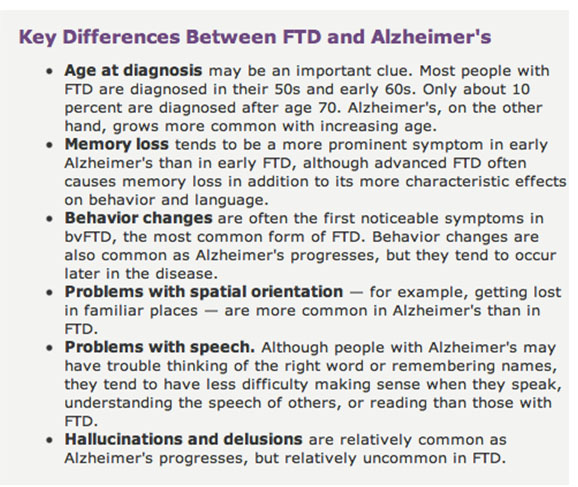FRONTOTEMPORAL DEMENTIA (FTD)
This can be referred to as Pick’s disease or frontal lobe dementia. The name indicates that two lobes are affected in this disorder. Brain cell death caused by FTD causes the brain shrink and reduce the function of both the frontal and temporal lobes which control planning, and judgment, emotions speaking understanding speech and certain types of movement.
In view of the damage to these two lobes the hallmarks of FTD are a gradual, progressive decline in behavior and /or language. FTD is most often diagnosed in persons of ages between 45-65. It is estimated that 10-20% of dementias are caused by FTD. It is now recognized as the most common type of dementia among a younger population. It affects men and women equally.
Symptoms: Different areas of the frontal and temporal lobes may be affected thus there are several subtypes of FTD. Based on the symptoms and clinical presentation three major types of FTD have been identified.
- Behavioral variant frontotemporal dementia
- Primary progressive aphasia (PPA)
- FTD movement disorders.
1. Behavioral variant FTD has a major affect on personality and behavior. Behavioral changes are typically seen as changes in personality, emotional blunting or loss of empathy that result in increasingly inappropriate social behavior
A person with behavioural variant frontotemporal dementia may:
- Gradually become less involved in routine daily activities and withdraw emotionally from others.
- Display little insight into how inappropriate his or her behavior is, and little or no concern for its effect on other people, including family and friends.
- Display repetitive, stereotyped behaviors, such as hand clapping, humming the same song over and over, or walking to the same place day after day. This can also include repeated use of phrases or gestures, hoarding and obsessions with timekeeping crave sweet or fatty foods ,lose table etiquette, or binge on ‘junk’ foods, alcohol or cigarettes.
- Lose their inhibitions – behave in socially inappropriate ways and act in an impulsive or rash manner; this could include making tactless or inappropriate comments about someone’s appearance
- Lose interest in people and things – lose motivation but (unlike someone with depression) they are not sad
- Lose sympathy or empathy – become less responsive to the needs of others and show less social interest or personal warmth; this can make the person appear selfish and unfeeling
- It is common for a person with behavioral variant FTD dementia to struggle with planning and organizing or making decisions. These difficulties may first appear at work or with managing finances.
2. Primary Progressive Aphasia (PPA) affects language skills in early stages, but often also affects behavior as it advances. The two chief forms of PPA have somewhat different symptoms: problems with expression of language and problems with word meaning.
A. Nonfluent/agrammatic PPA: people lose their ability to generate words easily, and their speech becomes halting, “tongue-tied” errors in grammar – a person may have ‘telegraphic speech’, leaving out small link words such as ‘to’, ‘from’ or ‘the’. Ability to read and write also may be impaired.
B. Semantic dementia, people speak easily, but their words convey less and less meaning. They tend to use broad general terms, such as “animal” when they mean “cat.” People experience a progressive deterioration of understanding words and recognizing objects
3. FTD movement disorders affect certain involuntary, automatic muscle functions. These disorders also may impair language and behavior. The two primary FTD movement disorders are:
A. Corticobasal degeneration (CBD), which causes shakiness, lack of coordination, and muscle rigidity and spasms.
B. Progressive supranuclear palsy (PSP), which causes walking and balance problems, frequent falls and muscle stiffness, especially in the neck and upper body. It also affects eye movements.
DIAGNOSIS: Like DLB there is no single test and FTD remains a clinical diagnosis based on the professional judgment of the doctor. MRI evaluation can be performed as it will detect atrophy in the frontal and temporal lobes.
Causes and Risk factors: In about 40% of the cases there is accumulation of an abnormal form of the protein TAU. The TAU protein may take on the form of Pick’s bodies. The only known risk is a family history of the disorder. Several genes have been linked to FTD.
According to the information on the Alz.Org website https://www.alz.org/alzheimers-dementia/what-is-dementia/types-of-dementia/frontotemporal-dementia the key differences between Alzheimer’s disease and FTD are below:

